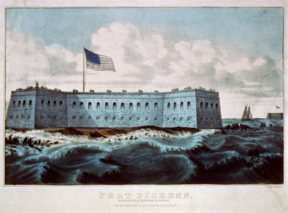Difference between revisions of "Fort Pickens"
(infoboxd!) |
m |
||
| Line 4: | Line 4: | ||
|caption=Lithograph of Fort Pickens, c. 1860s | |caption=Lithograph of Fort Pickens, c. 1860s | ||
|location=[[Santa Rosa Island]] at [[Pensacola Pass]] | |location=[[Santa Rosa Island]] at [[Pensacola Pass]] | ||
| − | |type= | + | |type=Pentagonal fort |
|built=[[1829]]-[[1834]] | |built=[[1829]]-[[1834]] | ||
|builder= | |builder= | ||
Revision as of 23:09, 3 May 2009
| Fort Pickens | |
|---|---|
| | |
| Santa Rosa Island at Pensacola Pass | |
| Type | Pentagonal fort |
| Built | 1829-1834 |
| In use | 1834-1947 |
| Controlled by | United States (1834-1947) |
| Battles | Battle of Santa Rosa Island |
| Events | Civil War |
| Present status | Decommissioned |
| Current owner | National Park Service |
Fort Pickens is a pentagonal historic United States military fort on Santa Rosa Island, at the entrance to Pensacola Bay. It is named after American Revolutionary War hero Andrew Pickens. The fort was completed in 1834 and remained in use in some form until 1947. Fort Pickens is currently part of the Gulf Islands National Seashore, and as such, is administered by the National Park Service.
Contents
Construction
French engineer Simon Bernard was appointed to design Fort Pickens. Construction on Fort Pickens lasted from 1829 to 1834, with 21.5 million bricks being used to build the fort. Much of the construction was done by slave labor.
Fort Pickens was the largest of a group of forts designed to fortify Pensacola's harbor. Fort Pickens supplemented Fort Barrancas, Fort McRee, and the Navy Yard. Located at the western tip of Santa Rosa Island, just offshore from the mainland, Pickens guarded the island and the entrance to the harbor. Its construction was supervised by Colonel William H. Chase of the U.S. Army Corps of Engineers. Ironically, during the Civil War some years later, Chase was later appointed by the State of Florida to command its troops and seize for the South the very fort he had built.
Civil War
By the time of the Civil War, Fort Pickens had not been regularly occupied since the Mexican–American War. However, Lieutenant Adam J. Slemmer, in charge of United States forces at Fort Barrancas, determined that Fort Pickens was more defensible than any of the other posts in the area.
His decision to abandon Fort Barrancas was hastened when, around midnight of January 8, 1861, his guards repelled a group of local men intending to take the fort. Some historians suggest that these were the first shots fired by United States forces in the Civil War. Shortly after this incident, Slemmer destroyed over 20,000 pounds of gunpowder at Fort McRee, spiked the guns at Barrancas, and evacuated about eighty troops to Fort Pickens. Despite repeated Confederate military threats to it, Fort Pickens remained in Union hands throughout the Civil War.
Late 19th century
The famous Apache Indian chief Geronimo arrived at Fort Pickens on October 25, 1886, where he was imprisoned along with several of his warriors until May 1887. Their families were held at Fort Marion.
During the late 1890s and early 1900s, new gun batteries were constructed at Fort Pickens. These batteries were part of a program initiated by the Endicott Board, a group headed by a mid-1880's Secretary of War, William Endicott. Instead of many guns located in a small area, the image most people have of a fort, the Endicott batteries are spread out over a wide area. This system used dispersement and concealment for protection from naval gunfire, which was more accurate and powerful than in the past. The use of the modern, powerful weapons eliminated the need for the concentration of guns that was common in the Third System fortifications. At Fort Pickens, one such battery was constructed physically inside the fort, while other similar concrete batteries were constructed to the east and west as separate facilities. The ruins of these later facilities are also included in the Gulf Islands National Seashore complex.
On June 20, 1899, a fire in Fort Picken's Bastion D reached the bastion's magazine, which contained 8,000 pounds of powder. The resulting explosion killed one soldier and obliterated Bastion D. The force of the explosion was so great that bricks from Bastion D's walls landed across the bay at Fort Barrancas, more than one and one-half miles away.[1] On January 30, 1903, five tons of condemned dynamite were detonated near the fort, about a mile away from the battery. The resulting explosion created a hole "large enough to hide a house" on the beach and was felt across Pensacola Bay in the city, cracking plaster and shattering windows.[2]
Hurricane Ivan
In September 2004, Hurricane Ivan battered the Gulf Islands National Seashore, causing extensive flooding, the destruction of a number of buildings, and a large number of felled trees. Despite the extensive damage, the actual fort "held its ground during the hurricane with only minor damage."[3]
Other images
References
- ↑ http://fcit.usf.edu/FLORIDA/photos/military/picken/picken.htm
- ↑ "Dynamite shook Pensacola." New York Times, January 31, 1903
- ↑ http://www.nps.gov/archive/guis/FLA/Hurricane%20Ivan/Hurricane.html










